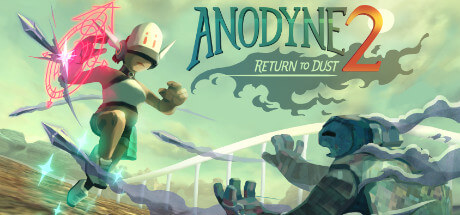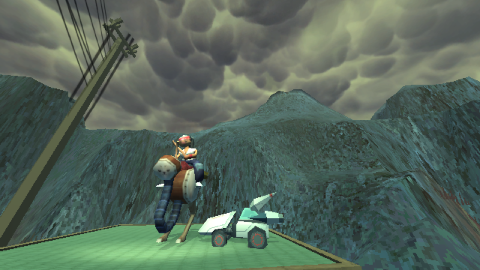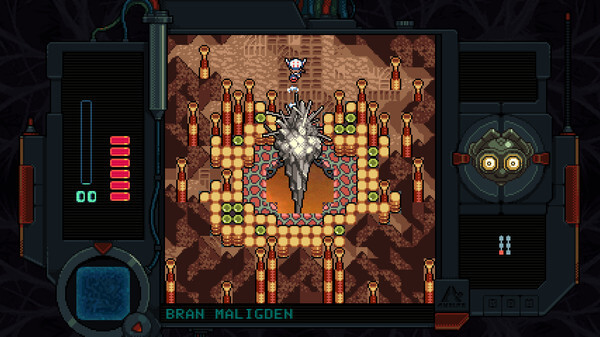
Trauma And Neglectful Parenting In Anodyne 2
It will still hurt. Nova can never truly be free from their trauma. But they chose the best possible path they could afford, and managed to save someone from having the same traumatic childhood as they had.
February 14, 2022
The core message of Anodyne 2 can be interpreted in several ways. There's the religious and cultural parallels, the queer angle ("Elegy Beatty" is still my favorite name in the entire game), and... whatever you choose to take out of the whole Desert NPC sequence. In this post I'll talk about the way I interpreted some of the game's narrative through the lenses of trauma and neglectful parenting. But first, a little intro to Anodyne 2 for those that might not know about the game.

Anodyne 2 was made by Melos Han-Tani and Marina Ayano, the latter of which also made Zonelets! This picture was taken from the game's Steam page.
Anodyne 2 is an exploration and puzzle game, divided into 3D sections with PSX-style models and 2D sections with 16 bit graphics. In it, you control a character named Nova, tasked by her two moms to clean the realm of something called Nano Dust which is affecting the residents in many different ways. Said moms work for the Center, which is... A place? A religious icon? A pool of magical resources? All of the above?

I feel obligated to mention that one of your abilities is turning into a car. I don't think this has a lore explanation. Screenshot taken by me.
This is where I have to put a spoiler warning for pretty much the whole game. I'll be talking about a lot of major aspects of the plot, and I would like you to have the chance to experience it for yourself if you are able to. As the title implies, the game is a sequel to Anodyne, but you don't need to have played it beforehand - the only thing you'll be missing are some location references and a (sorta non-canon) post-game bonus area tying the two together.
If you want to know more about the game but don't have the resources to purchase it, I recommend watching Nitrorad's video on it. I don't necessarily agree with all of his takes about the plot, but it's still a video I recommend regardless. I still reccomend you get the game and experience it for yourself when you're able to, or at least support the developers. Check out their upcoming 3D platformer, Sephonie!
I will be explaining things as I go along regardless, so strap in!
The protagonist of the game is a being called Nova, created by the Center to be a Nano Cleaner. Their job is to collect stray Dust, which is the thing every object and creature is made of in one way or another, but that can also be harmful in its raw form with varied effects in one's physical and mental health.
The most tangible form of dangerous Dust are the Nano-Assassins — microscopic parasitic beings that infect healthy organisms with Dust. Nova can shrink down to the same size as them, and they must do so to clean the host of the Dust infection. This changes the game from a low-poly PSX-like to a 16-bit top down puzzle adventure style game much like Link's Awakening — and most importantly, the first Anodyne game.
Raw Dust can be collected to fill up a reservoir in the middle of the game's hub, Center City Cenote, which opens up new areas after a certain amount is collected. Another important resource are cards, which contain little tidbits of flavor text about each of the game's beings — but their main gameplay function is to fortify the reservoir in order to make it able to store even more Dust.
That's more or less the basic premise of the game, so now I can start talking about what the title of this post actually says I'm supposed to talk about! Wahoo!
Nova was born inside an egg (world?) that serves as the game's tutorial. Their first task is to collect three items that represent sustenance, health and comfort. These benefits aren't directly administered to Nova, though, they are pre-requisites for Nova to be implanted with something called a Glandilock seed. Aside from that, they have two mothers (also agents of the Center) to help them on their way. They don't do much in the way of helping Nova with their job, though, it mostly falls to the Glandilock seed to guide them.
Though their guidance is a bit... lackluster, if not harmful.

Nova encountering a Dust Crystal, the main source of Dust which the Nano-Assassins protect. The Glandilock seed can be seen as the face on the right of the game's UI. Taken from the game's Steam page.
Nova starts having doubts about their job as soon as they start healing the infected. This is in part due to the fact that a lot of them aren't... actually healed. One of the first NPCs Nova is tasked to cure is a hungry creature with a big tongue that lost their sense of taste long ago and fell into a great depression. Being infected with Dust brought it back, but it also gave them side-effects such as a massive skin irritation which disfigured them completely. Upon being disinfected, they lose their wild new appetite, but their physical conditions remain and they rationalize it as the Center urging them to not give in to "desire". A desire which, while bad, was brought on because of the loss of one of their primary senses — which for a creature that is 60% tongue, might as well be a loss of their purpose in life.
One of the later NPCs even dies after being disinfected by Nova. Upon delving into their body — or rather, their memories somehow — Nova finds out that they were once the mayor of a town that had its fields infected with a fungus that prevented crops from growing. They tried to salvage the fields tirelessly at the cost of their personal relationships falling apart. In the end, all of the village's previous inhabitants had to move out because of the famine, leaving the mayor to their obssesion for an impossible task. Their family was heatbroken by the decision, but had to leave as well since the mayor no longer listened to anything they would say. Upon being healed by Nova, the mayor instead comes to the conclusion that they should have worked even harder, and promptly passes away due to exhaustion.
Nova is understandably shaken by all of this, having a breakdown before they had even completed four disinfections. One of their mothers, Palisade, comes in to comfort them and regrets even having given them such an important job so soon into their life. The other one, C Psalmist, shows no interest in Nova as a person, instead acting distant and giving vague nods to the importance of Nano Cleaning when the subject arises.
And what of the Glandilock seed, which was supposed to keep Nova healthy? Physically, it has done its job. Nova doesn't have to eat, rest, or worry about being infected with Dust themselves. But their emotional guidence is almost nonexistent. It only flares up when Nova has been away from their job for too long, instilling anger, shame and other negative emotions upon Nova to make them go back to their work as soon as possible.
Hopefully the metaphor I brought up in this post's title should start to become clear by this point. Nova's parents, in a way, take care of their basic need of food and shelter and expect Nova to follow an arbitrary objective without giving them enough help. Palisade is the only one that provides Nova the emotional support they need, but she suddenly explodes during one of the game's cutscenes for unknown reasons, leaving Nova truly alone in the world.
Nova's parents differ from the standard depiction of abusive parenthood in media by the fact that their abuse is this sort of passive neglect. Nova isn't getting shouted at, or beaten up, or deprived of their physiological needs. But they're not being truly loved enough to live a healthy life. Having Nova come out of their egg already grown up and doing a job also mirrors certain relationships in which the parents have their kid take care of insurmountable work and even emotional labor at a very early age.
The Glandilock seed, then, represents this sense of weaponized guilt that should be familiar to anyone that has suffered a similar treatment as Nova. It was planted there by their parents, but it's not directly caused by them, so it is harder to explain and justify to those that don't share similar experiences. It eats away at them, making them feel guilty about everything they do that isn't directly related to what their parents want of them.
By the time Nova comes to terms with their condition, it is already too late. The Glandilock seed has become too attached to their being, making it impossible to remove it. They can ignore it, they can recontextualize it, but the negative emotions will always be there, causing invisible damage to their mind. This is trauma, in its purest form.
Fortunately, things get better. In the game's (arguably) true ending, Nova fakes their death to try and stop the Center from imposing their harmful way of thinking into every being. In response, the Center scrounges what little resources it has to create a new Nano Cleaner, Zera. As a final act of defiance, Nova uses their Nano Cleaner powers to shrink into Zera and disconnect their Glandilock seed before it can root into their being too deply.
At first, this action seems to have killed and completely obliterated Zera, leaving nothing but a pile of their clothes on the ground where they previously stood. But upon closer inspection, it is revealed that Zera has actually turned into a baby. A baby. What Nova should have been born as instead of a fully grown individual with many burdens to bear. Together, they escape the island in which the game takes place. Nova acknowledges the Center's influence will always affect them, and so she chooses to distance themselves from it until its pleas no longer have any meaning to them. It will still hurt. Nova can never truly be free from their trauma. But they chose the best possible path they could afford, and managed to save someone from having the same traumatic childhood as they had.
Quite a realistic portrayal of dealing with trauma, isn't it? I was honestly surprised and very emotional when I connected all of the dots.
There are many more hidden meanings I can unpack from this game. I didn't even talk about the village which uses Dust as their life force and has a culture based around it, and yet has a perfectly happy and healthy life. But that doesn't have much to do with the initial subject, and I already got sidetracked enough. Maybe I will explore these other aspects in a future post? This one post has been in the making for quite a while, I might have to take some time before talking about Anodyne again. But there's much more I can say about this game, and one of these things is: please go buy it if you're interested in it! I know I kinda spoiled the whole game, but if any of this piques your interest then by all means look more into it and suport the creators if you can.
I haven't had a lot of time or energy to make blog posts recently, I'm wondering if shorter form posts would fit in this format. Let me know what you think on my Neocities page, or on my social media if you found yourself here from that as I will be linking them to this site soon.